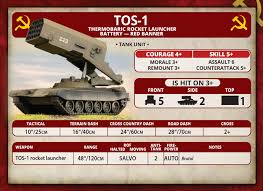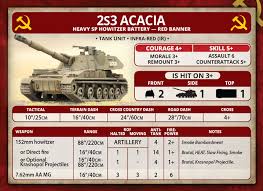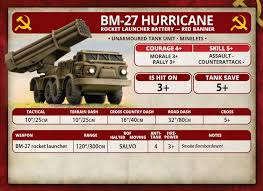TOS-UP Part III – Other Considerations
 By Jim Naughton
By Jim Naughton
PART III – (part 2 here) Now we’ll take a look at the complications – the effect of shifting targets, larger batteries, and Krasnopol. Refer to Battlefront’s source books World War III Soviet https://www.flamesofwar.com/hobby.aspx?art_id=7154 and World War III Warsaw Pact https://www.flamesofwar.com/hobby.aspx?art_id=7455 for details.
RANGING IN
The big weakness of artillery comes when your forces close in for the kill. ‘DANGER CLOSE’ makes you move the template, stop shooting or switch to smoke. PACT artillery suffers less than that of the Soviets. In fact, with an observer, it’s more likely to range in on the first attempt than the other two attempts combined.

There are only two things that affect ranging-in: a dedicated observer team and terrain under the template. The observer improves the range-in number and terrain degrades it, each by 1.
You can use a trick – firing a smoke barrage – to range in without penalty (pg. 56). It delays the impact of the artillery but usually prevents the intended target from shooting in its next turn.
Thus Soviet artillery has three possible range-in numbers: 4+, 5+, and 6+. PACT range-in numbers are 3+, 4+, and 5+.
Calculation of the probable effects of ranging-in is more complex than estimating the lethality. Luckily, it affects all artillery the same way.
The likelihood of failing to range in is easy to calculate. It is simply the likelihood of failing three times. In the typical (abysmal) case ranging in near terrain, the Soviets will fail 58% of the time. Lesson: have at least two batteries.
Ranging on any given die roll is NOT EQUAL probability. Why? You only use the 2nd if the 1st die roll fails, and the 3rd if the first two fail. So we need to use conditional probability rules to determine the probability of success on the second and third die roll. The general MATH statement of a conditional probability is P(2nd Success) = P(Failed 1st ) * P(success on one throw). This is the basis of the following table:
Table 6: Range-in Probabilities

The big lesson is that Soviet artillery needs their observer after the initial range-in markers become useless. Or be used in mass so at least one battery can range in. Frankly, in a fast-moving meeting engagement, I only expect smokescreens to matter. And typically leave some artillery in reserve.
You’ll notice that the likelihood of the 3rd Attempt mattering is always less than half the combined probability of the first two attempts. That means that if the Soviets succeed in ranging in, the chance of the whopping 2 number shift to the artillery’s To-Hit number is not high.
How do the reduced To-Hit numbers affect lethality? I’ll use the 6+ row in Table 6 and wave my hands a little to illustrate this, rather than calculating a lethality for each different attempt. The probabilities per attempt are almost the same for the 6+ row, so the ‘Expected’ to-hit adjustment would be the second attempt at +1.
TABLE 7: BASIC LETHALITY INDEX – Ranging In – Soviet – +1 To-Hit

I’ll repeat this for PACT but assess them as ‘most likely’ ranging in on the first attempt as the probability for ranging in on the first attempt in the worst situation (no observer, terrain, 5+) is almost as big as the other two attempts combined.
TABLE 8: BASIC LETHALITY INDEX – Ranging In – PACT – +0 To-Hit

We now have to recall Table Three from Part II for comparison:
TABLE 3: BASIC LETHALITY INDEX

What we see here is the combined effect of losing the repeat bombardment benefit and having, on average, a worse To-Hit number. TOS-1 now stands out versus infantry with a .18 because it has a Brutal bombardment. As does DANA for PACT, thanks to the autoloader effect which carries over to vehicles. The effect of that extra AP and the skill of PACT gunners shows up in looking at the BM-21, 2S1, and 2S3 rows in both Table 7 and Table 8.
Does the ranging-in affect matter in the choice of artillery? Somewhat. To decide how much of a nudge to give it, you must answer the question ‘how many times in a game will I shift fires?’ In a friendly game, played to the bitter end, it might happen three times. In a competition game, with time limits, it rarely happens twice.
Sometimes, not even once.
I expect to fire twice on my initial target and use smoke once, and the smokescreen can be used as a basis of shifting fires. Then fire twice more before the game is over. TOS-1 can’t fire the smokescreen. And thus has at least a 30% chance of failing to range in. Averaging over 5 turns BLI of .20. The BM-21, using smoke, gets four turns of BLI with repeat bombardments for an average of .11. The Lethality per AP drops to .04 for TOS and .06 for BM-21, so the nudge isn’t enough to make TOS more attractive.
But…the higher skill makes PACT artillery much more attractive despite the reduced ALI per AP. Here DANA shines.
However you arrange it, a Soviet battery usually loses one turn of shooting shifting fires. A PACT battery typically does not, and hits harder on the turn it ranges in on the second target. Over a five-turn game, a PACT battery will experience on average a 25 percent increase in lethality compared to the Soviet counterpart. And the flexibility gained in using smoke and shifting fires is an intangible benefit.
This leads up to our next topic, Super-sizing batteries.
SUPER-SIZE DOES NOT EQUAL EXTRA CRISPY
A battery firing a template with 5 or 6 artillery teams gets to reroll failures. That seems a substantial benefit and indeed I tried it early on with my 2S1s. When they repeatedly failed to satisfy, I sat back and looked at the MATH and discovered the fallacy in my thinking. 2×3 is greater than 1 x 6.

Why? It has to do with the range-in tables above. If using a pre-battle ranged-in marker, or luckily rolling success on first attempt, my to-hit number versus NATO is 4+. Half my dice should be hits, so my reroll benefit is +50%. I paid +100% to get this benefit. Ouch!
In fact, the only time that my barrage gets +100% benefit is if I fail the first two attempts to range in. If my range-in number was 6+, that’s 12% of the time. 5+, 15%. So I get full benefit at best 15% of the time. The average benefit for Soviet artillery is approximately +67 percent and for PACT artillery +60 percent.
If I fire two Soviet batteries at the same target under worst-case conditions, say 2S1s, at least one of the batteries ranges in 67% of the time, so I increase the chance to get some steel on target. In fact, both batteries will range in 17% of the time. With a 6-pack, it’s all or nothing. Nothing comes up 58% of the time. Firing two 3-packs of 2S1s at the same target generates a BLI of .36 while the 6-pack only generates .27.
To be sure, there are tangible benefits to a 6-pack. Firing without the template, you get one shot per tube. 100% more shots for 100% more points. But that only affects the howitzers; the SALVO template weapons are stuck with a 60%-67% lethality benefit for the extra points.
Increased survivability has some utility, particularly in a counterbattery fight or if NATO attack helicopters are ignoring your tanks.
And unique capabilities may be strong enough to argue for doubling the weapons which are only available in one slot. E.g. TOS-1 or BM-27. If considering that route, note what lethality the extra points will buy in another artillery system. For example, a 6-pack of TOS-1 under optimum conditions against infantry has a BLI of .83. A 3-pack of TOS-1 plus the two 3-packs of 2S1 that you could buy with the extra 10 AP generates a combined BLI of .55 + 2 x .18 = .91. And gives you two smokescreens.
With PACT weapons, the likelihood of hitting on the 3rd Range-in-attempt is so small compared to other possibilities that the benefit is always less than the cost bump. Two PACT 2S1s are always better than a single large battery, and a 6-pack of DANAs is less lethal than a 3-pack of 2S1s and a 3-pack of DANAs.
JUST SAY ‘NO’ TO KRASNOPOL
When Red Thunder was published, I quickly acquired my 2S3s and excitedly experimented with Krasnopol. This made the battery cost 7 points. In three games, tricky NATO players obliterated my Observer on GT1. I got a total of 9 shots off and scored precisely one hit. My NATO opponent in that game rolled a ‘6’ for his top armor save. He only needed a ‘3’. Copperheads these aren’t, thinks I.

I haven’t paid the extra points since. Setting aside the obvious problem with keeping an observer safe while simultaneously using him, MATH says this isn’t cost-effective.
First, the Artillery Unit must be eligible to fire a bombardment. In meeting engagements, the first mover’s artillery is ineligible. So despite this attack working much the same way as a direct fire, it’s not available. In a meeting engagement, the opponent always gets one crack at the observer. You can’t even protect him with a smokescreen!
Say your observer survives to call a shot. Or you have the first turn. Three Krasnopol fly down range. If the target was a NATO MBT that fired, the BLI is .17. If concealed and gone to ground, .09.
Fire a bombardment. Assume three tanks under the template. We have an observer, or we couldn’t fire the Krasnopol. Use the BLI-RI table. Cumulative BL = 3 x .05 =.15.
I paid 40 percent extra to get a .02 increase in BLI, or a 13 percent increase in lethality. Typically, for one turn. If 4 or more tanks are under the template, or if a mix of targets, or if gone to ground, straight bombardment is better. Only if sniping one isolated tank does Krasnopol shine.
And after GT 1, usually, the points are wasted.
Perversely, using Krasnopol in a six-pack is better, because the six-pack bombardment isn’t as effective as two three-packs, and a second battery of 2S3s is not an option. The Krasnopols now give a cumulative BLI of .34. The bombardment yields .25. For one turn the Krasnopols reign supreme. Then reality intrudes.
So if you are determined to use Krasnopol, ignore my earlier advice and buy a 6-pack of 2S3.
For my part, I just say NO to KrasNOpol.
My Technique
I play an aggressive game tailoring my artillery accordingly. 15% AP invested in artillery seems right. At 60 AP or less, that used to be a 2S1 and an observer. Now it’s a BM-21, and sometimes an observer, and/or sometimes a 2S1. The 2S1 remains prime for me because I can always use it as an assault gun (however briefly).

Next up has been 2S3, although I’m now considering BM-27 replacing the BM-21 instead of taking the extra unit. That takes me through the hundred-point level. TOS-1 is attractive, but so are two batteries of 2S1, 2S1 plus 2S3, or BM-27 for the same points (or less). The single minefield I can get with three BM-27s is an attractive gimmick.

PACT choices are more limited and very much determined by nationality (East Germany couldn’t afford DANAs so they are not an option). The extra skill bump is very useful, and if you play Poles or Czechs, the DANA is definitely worth having (in a 3-pack!).

When you blend allied forces, you’re essentially choosing between DANA and TOS/BM-27. BM-27 wins IMHO because it triples the area denied by the template, throws smoke and the price is essentially the same as DANA. TOS is too much of a one-trick pony for competitive games but has a niche when forced to attack UK infantry. But don’t forget your PACT Ally 2S1s!
Wrap-Up
Like most things in gaming, there is no definitive answer. I presented the lethality of the various Soviet/PACT weapons, assessed their lethality per AP after ‘normalizing’ for template size, explained why two batteries outperform one big battery, and examined Krasnopol. When you choose 2S1 for direct fire potential over 2S3, you know how much lethality you are losing.
But no simple way assesses the compensating value of blasting marauding Bradleys or taking out an Abrams in a meeting engagement. Style of play will dominate those decisions. Referring to the above tables will help make it an informed decision.
All in all, it’s a TOS-UP.

Please check rules on Krasnopol. Coming from the US-FIST/Copperhead-Combo it’s a common misconception that Krasnopol also needs the dedicated Observer-BMP.
But if iirc the rules only say spotter, not observer for directing Krasnopol.
Wired considering the the step behind in technology status connected to the eastern block, but due to this the loss of the Observer-BMP is not affecting Krasnopol as the loss of the FIST prevents Copperheads…
The rules on Krasnopol (pg 57, WWIII Team Yankee Soviets) essentially duplicate the rules on pg 55, Laser Guided Projectiles, in the rulebook. They replace ‘Laser Guided Projectiles’ with ‘Krasnopol’ and add the Krasnopol characteristics (attack top armor). Both places say Observer Team, not Spotting Team as found in normal ranging in rules pg. 51 and pg 53 in the rulebook. The Observer Team is one with the Observer wonder power (pg 69). Pg. 7, FM101 (BF’s FAQ for Team Yankee) specifically says that once the Observer Team is destroyed, laser-guided projectiles are useless. I don’t think it can be any clearer.
Jim Nice set of articles. I normally have 2 formations in my Pact and Soviets lists and each has a Carnation 3 pack. I’m a big fan of the 2S1 and its AT-21. I usually try placing them near objectives but terrain sometimes dictates a different deployment. I tried the RM-70, DANA, and BM-27. What I have found is that they become shot magnets and points of focus for my opponent’s Air Attacks and Artillery barrages, with Salvo Templates.
The RM-70 and Dana are more survivable than the BM-27. For some reason my opponents normally ignore my Carnations go figure.
One of the other issues I had with the RM-70, DANA, and BM-27 artillery units is their size and finding large enough or deep enough terrain pieces to hide them in. The older BM-21, 2S1and 2S3 are definitely easier to find places to deploy them in or behind.
Thanks. Survivability is a dimension I chose not to explore because it’s hard to account for differences in play style in a numerical analysis, much less how the enemy structures his armies. There definitely is an issue with hiding moving vans on 4’x6′ tables, particularly if the local meta is 4″ diameter terrain. Another difficulty is the opponent’s opportunity cost when the choice is counterbattery (slow kill) versus trying to stop an infantry attack (which if successful, will cost the game).
Interesting again. Torn now, 2 x S1 or 1 x S1 and 1 BM-27. I do like that TOS-1 model though. Cool has to trump effect sometimes LOL. BM-21 is a pass I think, at least at first.
A lot will depend on how your opponent reacts – not just to your artillery choice but also in Battle Plan selection. One big qualitative effect is created in games with pre-ranged markers where you can deny access to an objective with a salvo template. I’ve seen BM-21 win games even in V1 because the opposition planned to move onto the objective after neutralizing the BM-21s and that happy (unhappy for me) event never occurred. With repeat bombardments being brutal, it takes nerves of steel to deploy on an objective covered by a brutal 3+ bombardment…but you have to bring a lot of flak for BM-27 to stick around long enough to exploit the effect if the opponent double-dog-dares you by placing his Irish Guards on the objective. Measures, countermeasures, counter-countermeasures.
True. Likely a good idea to at the very least have one of each platform option in the arsenal, salvo only and direct. In that regard I think I’m definitely sold on the S1 being in and, on balance, probably the BM-27 over the TOS-1, at least in terms of what to buy first.
Be interesting to see a similar series, or even a single article (given there are fewer platforms with perhaps less of a spread of variables) on the anti-air options.
Solid choices. As to AAAV and SAM, so it is written, so it shall be done.
Cool. I’m actually at a crossroads at the moment. The range of numerous units in TY is well upwards of 72″, 120″ is the longest I’ve found so far. That, coupled with the fact that I’ve seen it suggested countless times to reduce the points on a 6 x 4 table (the size we mostly have access to), we are most likely going to go down the 6mm route (using GHQ it actually works out almost as expensive as you don’t get any of the BF box set discounts in terms of individual model cost). Still relevant articles of course, we just decided we didn’t want to end up playing a hobbled version of the game where range doesn’t really matter, or with constrained manoeuvre due to playing length-wise in order to make at leat SOME ranges count. Drop to to 1″ = 1 cm but keep the standard command distance of 6″ to stop bunching up.
Been playing TY since Iron Maiden came out with a lot of variations. I’ve complained in my group about most of the issues that turn up in social media, done some critical thinking, and decided the BF meta is the best compromise between modelling and gameplay, including 4×6 tables at 100 AP. During the RED THUNDER/STRIPES Global Campaign we saw a couple groups do as you suggest with Microarmor. And I’ve played TY remotely using COUNTERS and MAPS from the old GDW (not GW) Assault series games. So alternatives are available, but…you won’t be able to transfer experience if you cross-pollinate with another group. Weapons ranges are only relevant to the terrain compartment, and unless gaming Desert Storm no sightlines should be longer than about 56″ (48″ = TOW Range = 3,300 or so meters = horizon in flatlands unless shooting from elevations to low ground. That’s why USA designed TOW with that range. In Europe, Iran, hilly Israel/Lebanon/western Syria terrain compartments average 2.5 km, or about 36″. Sure you can engage medium bombers at 1,500 feet altitude for 10 km but nobody flew strike aircraft or attack helicopters that way in 1985…they all got the AAR from Vietnam. And the relative weapons ranges are a sliding scale where assault rifle range of 8″ (arguably 200 meters) is 25 percent of typical missile range (48″ or 3 km). WE sometimes play mass battles on bigger tables (6×8 and 4×12) and guess what? Unless you take SPEARHEAD and SMOKESCREEN out of the game, the battle starts 16.1″ away from the NATO deployment zone, with a PACT SMOKESCREEN the width of the table 6.1″ out of the NATO deployment zone covering PACT first move. Making the table size and most weapons ranges IRRELEVANT no matter how deep unless playing ‘a couple bridges too far’ – a chained scenario with an enormous NATO backfield on 4×12. The universal constant of bigger tables is my back hurts after the game, and the other universal constant is everybody standing on the NATO side of the table after turn 1 because you can’t reach PACT toys from their side…so other than visual appeal of having spread out tanks big tables buy you little (but allows putting a Soviet regiment in full cry on the table vs NATO battalion). The 6mm will work effectively making 4×6 into 8×12 but when you template the given scenarios…all the attacker vehicles except artillery and ADA start 16.1 cm from the defender’s deployment zone. Try it with cardboard bases before making the investment. But however played it’s a good game.
Thanks very much for the comments, very helpful. I said I was at a crossroads and there is a VERY simple reason for that not being having been just a simple decision. BF models!!! At 6mm it’s just not so appealing. It’s the models that drew me to the game and, IMO, particularly when you factor in the discounted prices that the starters give you (about £150 on individual model costs if you buy the T-80, American and Complete Starter), they are quite reasonably priced. In fact, I priced up buying all of what I would buy (at least at first), enough to provide a reasonable range of options, from GHQ (OK they are THE most expensive 6mm but the are expensive for a reason) and to buy the Soviet side for BF would cost around £250. From GHQ it would be £225! So, a 10% drop in costs for a 90% drop in visual appeal, at least for me.
We planned to deal with the ‘car parking lot’ issue by using elite and expensive formations. M1A1 vs T-80 Shock, keeps costs down too. The only reason I stalled is that I didn’t want range NOT to be an issue. Weapons with 84, 92, 120″ ranges, what’s the point on a 6 x 4? That said, you don’t NEED to be firing a weapon at max range to get the benefits from it I guess. Still the only thing I’m a bit reticent about though BUT, the scenario deployment distances I’d not considered. The other thing that cropped up to bug me then at the other end of the scale, the Apache Chain gun has only a 6″ range, in cm that would be around just 2″. I know some play in 6mm and keep the ranges etc the same, no point for me doing that though, the ranges are the only reason making me consider 6mm, but thinking more, there are at least as many negatives as there are positives and the ‘weighting’ of that visual appeal negative for 6mm may well win out.